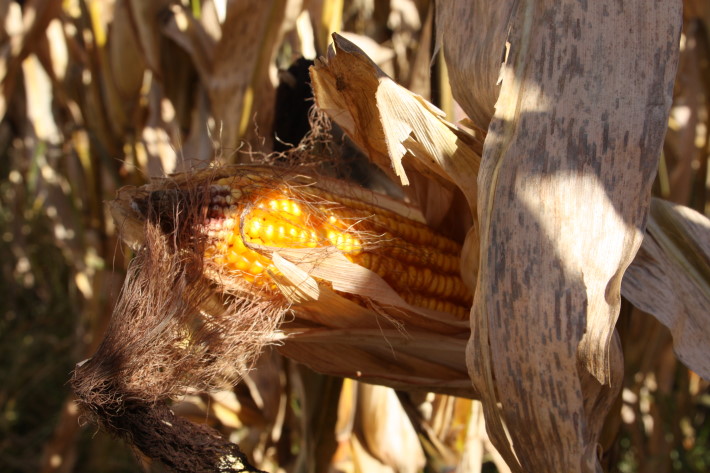
Agricultural News
Ending Corn Stock Totals Left Alone- But Ethanol Useage Edged Higher
Mon, 11 Apr 2011 7:20:48 CDT

USDA's World Agricultural Supply and Demand Estimates, released on Friday morning contained hardly any changes
for corn and soybean supply and usage but also did little to shed any new light on last week's surprising Grains Stocks estimates. According to Steve Meyer and Len Steiner in their Daily Livestock Report from the CME, the reports from USDA on Friday only confirm that available stocks of feed grains are tight and that won't change the balance of this year.
They add- Recall that the Grain Stocks report pegged March 1 corn inventories of 6.52 million bushels, 15% lower than one year ago and
nearly 170 million bushels (2.5%) lower than the average pre-report estimate of grain market analysts. That shortfall would imply that
one of two things should happen:
Corn usage for the rest of this year must be reduced in order to make already-tight projected carryout stocks of 675 million
bushels (about 18 days of usage) last until the bulk of new-crop harvest begins, or
Year-end stocks must be reduced if less is available and present usage rates remain the same for the next 6 months.
It is perfectly plausible that both could happen, of course, leading still to some reduction in year-end stocks.
But in its Friday report, USDA says that neither will happen as it left total usage constant at 13.5 billion bushels and year-end
carryout at 675 million bushels. USDA increased ethanol usage by 50 million bushels, quite correctly citing favorable markets for ethanol
producers. Those markets were made even better on Friday when nearby May Crude Oil futures closed at $112.79, their highest
level since September 2008. The ethanol increase was offset by a 50 million bushel decrease in estimated feed and residual usage.
Current indications are that hog numbers and chicken numbers will be marginally higher than last year. Feedlot inventories remain well
above year-ago levels but widely-expected lower placements will not be seen until this summer meaning that those year-on-year higher
inventories may persist to near the end of this crop year. There will be some more DDGS available but only one-third as much as the
feed/residual usage number is projected to fall. How will feed usage decline much from the previously-forecast levels?
USDA's answer and very likely a correct one is that more wheat will be fed since spring wheat plantings were up 5% from
last year, crop conditions are good and winter wheat conditions are good in the Southeast where wheat can be effectively used as a
substitute for corn in hog and poultry diets., Add in wheat prices that are low enough for wheat to compete with corn and one certainly
can make a case for higher wheat feeding. The only problem is that USDA did not include higher wheat feed usage in the WASDE report,
leaving it steady at 170 million bushels. The only changes in USDA"s wheat supply and use table were a 4 million bushel increase
in seed and corresponding 4 million bushel reduction in projected ending stocks, now set at 839 million bushels, down from last
year's 976 million bushels.
It appears that futures markets were having none of it on Friday with corn futures gaining 7-3/4 to 10-1/4 cents. Friday's closing
prices were the highest closes ever for May and July and contract life highs for all other contracts except December which traded at
higher levels the first three days it was on the board back in July 2008. Chicago wheat futures rise by 19-3/4 to 24-1/4 cents per bushel
as well while Kansas City hard red winter wheat gains 9-1/4 to 10-3/4 cents/bushel. Dry conditions in major wheat growing regions of
Oklahoma and Texas also contributed to higher wheat prices.
USDA made few changes to its projected supply and use of soybeans as well. 2010-11 crushings were reduced 5 million
bushels while exports were reduced by 10 million bushels and seed usage was reduced by 2 million bushels, reflecting lower planting
intentions. "Residual" soybeans, which, unlike corn, USDA estimates as a separate usage line, was increased from 19 to 36 million
bushels putting is at double the residual of last year. The net impact on projected year-end stocks was zero they remain at 140
million bushels, a record-low 4.2% of annual usage. That is just over 15 days of soybean usage. CME Soybean futures contracts
gained 28 to 30 cents/bushel on Friday, helped along by a weaker dollar and higher oil prices which spurred gains of 1.45 cents per
pound for soybean oil.
It doesn't appear that any of those markets viewed Friday's news as neutral - or even confusing for that matter.
Grain markets shrugged of the S/D news, clearly believing that demand is still strong and stocks will get tighter. The bottom line for the
meat and poultry sectors is HIGHER COSTS pending the result of this year's crops. Same song and even the same verse.
Click on the PDF file LINK below for the full report from the CME.
dlr 4-11-2011.pdf
WebReadyTM Powered by WireReady® NSI
Top Agricultural News
More Headlines...



















